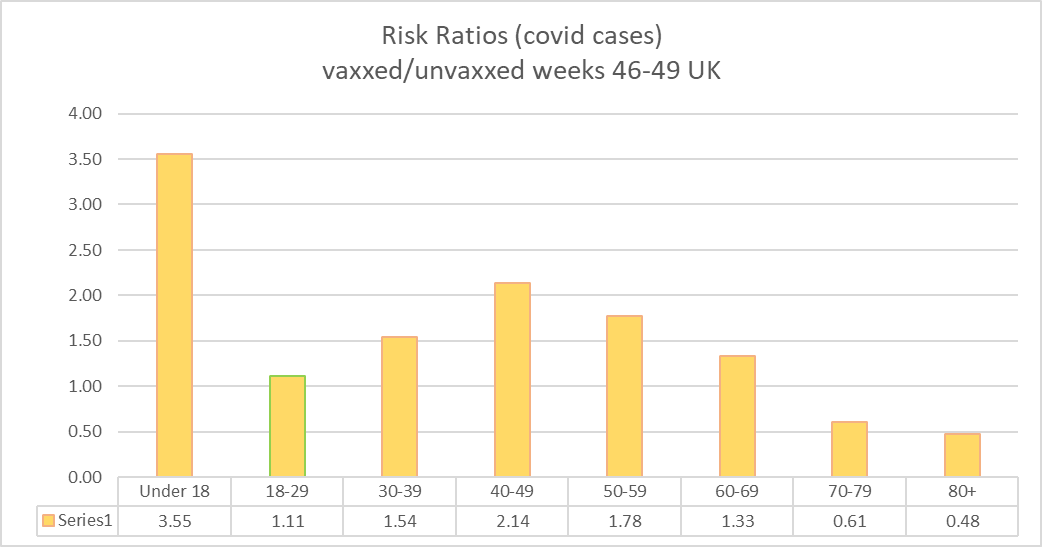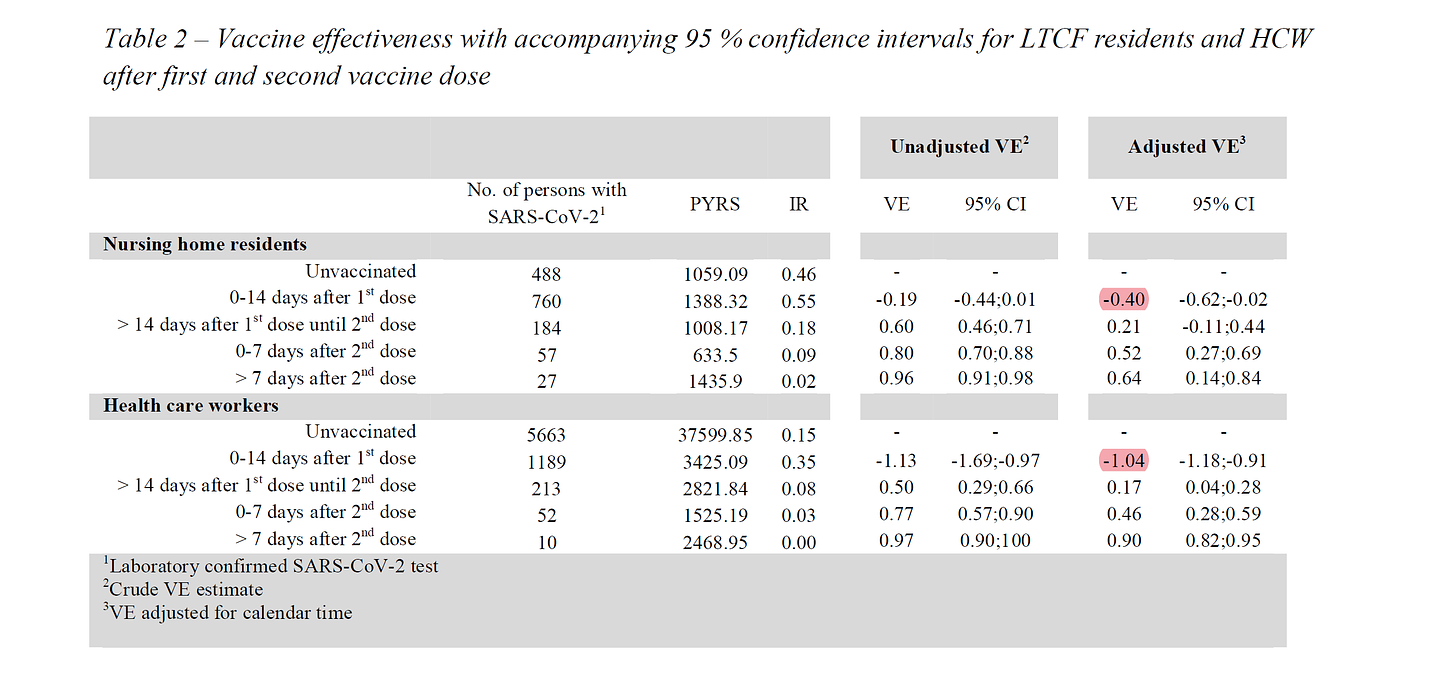
more evidence on omicron vaccine evasion and antigenic imprinting
UK and danish studies show strongly negative vaccine efficacy for cases.
more studies keep emerging on omi-covid and vaccines and their findings increasingly align with the emerging anecdotal evidence that not only is omicron affecting the vaccinated and the boosted, but is likely doing so preferentially with infection rates among the vaccinated exceeding the unvaxxed which likely points to issues with antigenic imprinting (OAS) that has locked immune systems into less effective and non sterilizing response patterns.
these are not RCT’s. they are observational and they are smallish, so we are far from “gold standard” territory here and more into “mosaic” but the pieces are starting to become plentiful enough that we can get a sense of what we’re looking at.
first off, we look at the UK. they used to provide a great, age-segmented chart showing relative infection rates for the vaxxed and unvaxxed. (note that this ends week 39)
alas, they no longer do so (likely because the comparison made vaccines look bad) but they do still provide the data to allow for the calculation.
i ran it here:
note that this is for all cases, not just omi.
as can be seen, vaxxed (i included all people with one or more doses) underperforms quite significantly. i would urge caution with both the under 18 and over 70 results as the testing levels vary materially from genpop (far higher for kids, far lower for oldsters and have further bias injected by testing those unvaxxed systematically and excusing the vaccinated form such tests, and issue that is, frankly, prevalent in all this data and likely overstates VE)
the UK does seem to have some data on omicron published by the office for national statistics.
why this is done off to the side and not by the same people doing the vaccine and variants reporting is anyone’s guess.
it’s a small sample size of only about 1,760 cases (from an undisclosed N of overall individuals) but has an interesting feature that i wish more people were using as it weeds out a lot of the trace exposures, non-clinical cases, etc:
2. Only individuals who test as a strong positive (Ct<30) are included, since weaker positive results of the Delta variant could be identified as probable Omicron. The model identifies the probability of these individuals having probable Omicron.
all data is from private households and not from hospitals etc.
i plotted it graphically:
obviously, this does not look great for vaccines. the methodology by which this is generated is, frankly, a bit over-complex (why they used a spline analysis vs age segmentation is a question i’d love to get some insight into) and opaque and i do not have access to the base data so i’m just presenting it as is from the UK office of national statistics.
they did similar for “work status” but frankly, i suspect this is so polluted by bias from relative testing rates as to contain little actual signal.
there is also a danish study HERE.
interestingly, it shows positive VE from vaccines vs delta, an outcome that diverges meaningfully from the UK data. it is not immediately clear to me what the source of this variance in outcome is. would love to hear some ideas if people have them.
it also adds a temporal aspect showing the now all too familiar “vaccine fade” that becomes very rapid after 90 days (once more raising some VERY pointed questions about why the vaccine trials and data were ended at 90 days. companies like pfizer so not make mistakes like that. they make choices…)
overall, efficacy vs cases drops to near zero after 60 days and sharply into the negatives afterwards.
some folks are using this as a pretext to claim that this means you should go get boosted immediately.
however, this is FAR from clear. that may, in fact, be very bad and dangerous advice.
it was clear from several studies (such as this one) that these mRNA vaccines induce ~2 week period of immuno-suppression post administration
this is a now well established issue with these vaccines. shutting off TLR receptors and other forms of immune suppression is a known and serious issue.
encouraging this sort of immune suppression during peak covid seasons is NOT sound policy. it’s more like gasoline on a fire than water.
note that ALL the data above hides this issue by only counting those “vaccinated + 2 weeks) this represents a deliberate choice to hide risks and mislead the public and medical community. (detailed in link below)
unless the health agencies and drug companies are really too ignorant and incompetent (possible for agencies, implausible for drug companies) to know this, then pushing boosters right now during peak covid would seem to be overt medical malpractice. the last thing you want with disease everywhere is to suppress your immune system.
what i would LOVE to see is the data on the boosted getting covid right from the date of the jab, not starting 2 weeks later.
that seems like palming a bad card and sneaking it into the other player’s hand. it will result in exceedingly rigged data as those who get covid in this period of enhanced risk caused by the booster will get called “non-boosted covid.”
this may be why the double boosted VE is rocketing into the basement: it’s being heavily salted by the immuno-suppressed booster +0-14 days cohort.
this is all still mosaic data in the process of assembly, but thus far it seems to point fairly strongly to:
omi is vaccine evading
omi looks enhanced vs those with vaccination, likely due to OAS
boosting during a surge carries immunosuppression risks that are being hidden in order to push policy that looks ill conceived
more and better data will emerge. things may change. but so far, this looks like the odds on hypothesis.
will keep staring at it.


















In other words, Pfizer did NOT run any chronic (6 months or longer) clinical studies on their vaccines. If I recall correctly from my days at the research lab, a 90-day (three month) study was considered subchronic. Also, I have not heard anything at all about the types of studies that were conducted either by Pfizer or the other manufacturers. Specifically, I would want to know about studies (either clinical or preclinical) involving reproductive and fertility parameters, oncogenicity, carcinogenicity, neurotoxicity, cardiovascular and pulmonary parameters, safety and efficacy, among other things. What kind of long-term effects are we looking at? Even in short-lived species like rats, 90 days isn't enough to determine this sort of thing, you want at least a two year study. As I said I spent nearly 4 decades in the business; if someone wants to talk vaccine safety with me, then they'd better be able to demonstrate they know and understand the terms I just used above, and that includes my present employer. Don't just quote something you got off the CDC website, show me you know your stuff.
What I understand so far:
1. The PCR test was never intended to be a method to diagnose COVID.
2. Using this test to dx COVID yields a 90% False Positive rate.
3. The PCR test cannot distinguish between COVID or any other coronavirus or the flu.
Bearing this in mind, how can variants possibly be diagnosed from a PCR test? How can any coronavirus or flu be eliminated as the cause of the person's illness?
I think this is a bigger hoax than people realize.